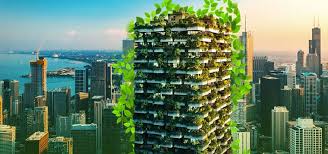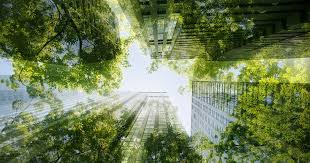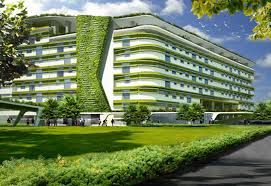Green building, also known as a sustainable or eco-friendly building, is a structure designed and constructed with the goal of minimizing its negative impact on the environment and maximizing its efficiency and sustainability throughout its lifecycle.
Green buildings typically incorporate various practices and technologies to reduce resource consumption, promote energy efficiency, improve indoor air quality, and minimize waste, ultimately contributing to a healthier and more environmentally responsible built environment.
These practices often involve the use of renewable energy sources, efficient insulation, water conservation, and the integration of natural elements into the design.
Green building, also known as sustainable building or eco-friendly building, is a revolutionary concept reshaping the way we construct and live in our homes and offices. It’s not just a trend; it’s a smart and responsible choice that benefits us and the environment.
In simple terms, green buildings are designed and built with the planet and people in mind, aiming to reduce negative impacts while creating healthier, more efficient spaces. Let’s delve into what makes green buildings so special and why they matter.
1. Energy Efficiency: One of the standout features of green buildings is their energy efficiency. These buildings are like well-insulated thermoses, helping you stay comfortable while using less energy. They incorporate smart design elements like energy-efficient windows, solar panels, and improved insulation to reduce heating and cooling needs. This not only saves money on utility bills but also reduces our carbon footprint.
2. Water Conservation: Green buildings are masters of water conservation. They use innovative technologies like low-flow faucets, rainwater harvesting, and greywater recycling to minimize water waste. So, you can enjoy your showers and have a lush garden without draining precious water resources.
3. Indoor Air Quality: Breathing clean air is a must for a healthy life. Green buildings prioritize indoor air quality by using low-VOC (volatile organic compound) paints and materials, efficient ventilation systems, and natural airflow. This means fewer allergies, better concentration, and improved overall well-being.
4. Sustainable Materials: Green buildings are like puzzles made of sustainable pieces. They use eco-friendly materials like bamboo flooring, recycled steel, and reclaimed wood. These materials are not only kind to the environment but also durable, ensuring your building stands the test of time.
5. Natural Light and Green Spaces: Who doesn’t love a sunlit room or a mini indoor garden? Green buildings maximize natural light and often incorporate green roofs or indoor plants to create a healthier, more pleasant living or working environment. It’s like bringing a bit of nature indoors.
6. Reduced Waste: Green buildings are champions of waste reduction. During construction, they minimize waste through careful planning and recycling of materials. This not only saves resources but also reduces landfill contributions.
7. Renewable Energy: Solar panels, wind turbines, and geothermal systems are common sights on green buildings. They harness renewable energy sources to power your space sustainably. You might even see excess energy being fed back into the grid, reducing your bills and benefiting your community.
Green buildings are more than just structures, they are a statement of our commitment to a sustainable future. They offer us comfortable, healthy, and efficient spaces while reducing our impact on the environment.
Whether you’re building a new home, renovating an old one, or working in an eco-friendly office, green building principles can make a world of difference. It’s not just about construction, it’s about building a better world for generations to come.
Read Also: Exploring the Causes and Effects of Pollution
The Importance of Green Building

Green building is more than just a trend, it is a crucial step towards a sustainable and healthy future for our planet and everyone who calls it home. Let’s explore why green building is so important in easy-to-understand terms.
1. Saving Energy and Money: Green buildings are like wizards when it comes to saving energy. They use smart designs and technologies to keep your home or office comfortable without gobbling up too much energy. This not only cuts down on your bills but also reduces the pollution that harms our environment.
2. Protecting Our Water: Green buildings are like water-saving heroes. They use special gadgets to use less water, like low-flow faucets and clever systems that catch rainwater. By using water wisely, green buildings help ensure there’s enough clean water for everyone.
3. Healthier Living Spaces: Green buildings care about your health. They use materials that don’t make the air inside your home or office yucky. Plus, they bring in fresh air, which can help you feel better and stay healthier.
4. Being Earth-Friendly: Green buildings are like Earth’s best friends. They choose materials that are kind to the planet, like bamboo and recycled stuff. By doing this, they reduce the harm we do to nature.
5. Bringing Nature In: Who doesn’t love sunlight and greenery? Green buildings make sure you get plenty of both. They have big windows to let in sunlight and even gardens on the roof or inside. It’s like having a bit of nature right where you live or work.
6. Less Trash, More Treasure: Green buildings are experts at reducing waste. When they’re built, they don’t throw things away. Instead, they reuse materials, which means less trash in landfills and more valuable resources saved.
7. Harnessing Natural Power: Green buildings use the power of the sun and wind. You might see solar panels on the roof, which soak up the sun’s energy. They might also use wind turbines and heat from the Earth. This means less pollution and more renewable energy for everyone.
Green building isn’t just a fancy idea; it’s a crucial way to make our world better. These buildings offer us comfortable and eco-friendly spaces while taking care of our planet.
Whether it’s your home, office, or a community project, green building practices make a big difference. It’s not just about constructing buildings; it’s about constructing a brighter and greener future for all of us. So, let’s choose the green path, it’s the way forward to a better world.
Read Also: A Guide to Recycling Future Trends
The Goals of Green Building

Green building has clear goals that guide the construction of homes and offices in a way that’s good for people and the planet. Let’s explore these goals in straightforward terms.
1. Save Energy: Green buildings aim to use less energy. They’re designed to keep temperatures comfy without using too much heating or cooling. This goal not only cuts down on energy bills but also reduces harmful pollution from power plants.
2. Use Water Wisely: Green buildings are smart about water. They use gadgets that save water, like low-flow faucets and rainwater collection systems. By using water wisely, we ensure there’s enough clean water for everyone.
3. Provide Healthy Spaces: Green buildings care about your health. They use materials and systems that improve indoor air quality. Breathing clean air indoors can help you feel better and stay healthier.
4. Be Earth-Friendly: Green buildings choose materials that are kind to the Earth. Materials like bamboo and recycled stuff are used to reduce harm to nature. This goal is all about being friendly to our planet.
5. Maximize Natural Elements: Green buildings make the most of natural elements. They use sunlight through big windows and sometimes have gardens on the roof or inside. It’s like inviting nature into your living or working space.
6. Reduce Waste: Green buildings are experts at reducing waste. During construction, they reuse materials and limit waste. This not only saves resources but also lessens the trash that ends up in landfills.
7. Use Renewable Energy: Green buildings harness renewable energy sources like the sun and wind. You might see solar panels or wind turbines on them. This means cleaner energy and less pollution.
The goals of green building are like a roadmap to a better future. They ensure we have comfortable, eco-friendly spaces while taking care of our planet. Whether it’s a home, an office, or a community project, these goals make a real difference. It is not just about building; it’s about building a brighter and greener tomorrow for all of us.
Read Also: 16 Medicinal Health Benefits Of Passion Flower (Passiflora incarnata)

